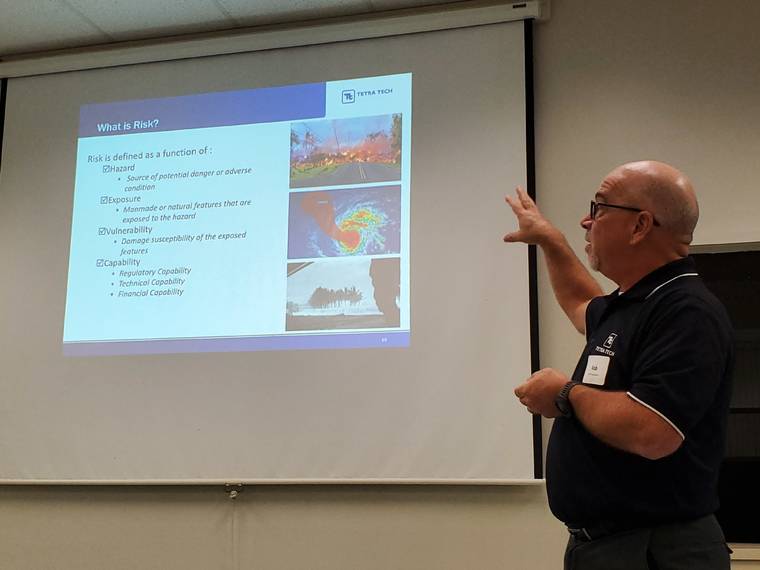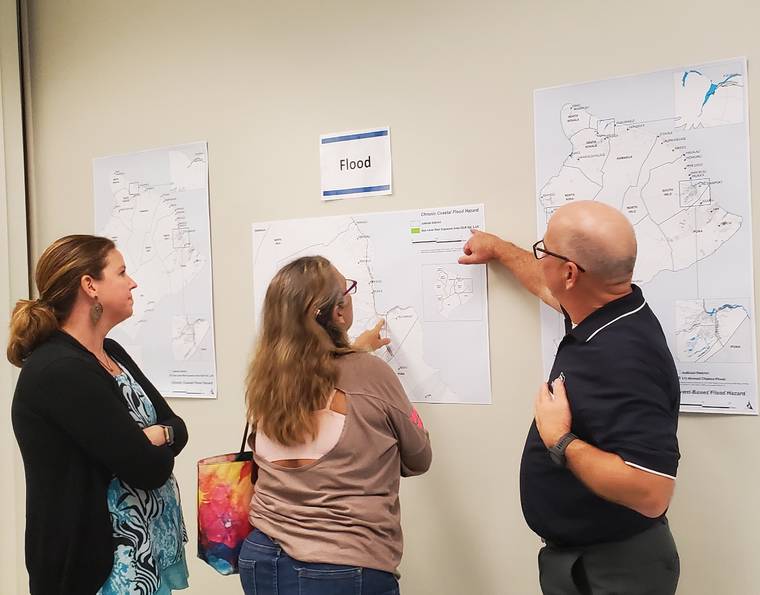A small group of individuals turned out Wednesday to learn more about the pending update to the county’s multi-hazard mitigation plan.
The meeting — held in Hilo and hosted by the county Civil Defense Agency — was the first of four scheduled around the island and offered individuals a chance to share their views on risk mitigation and make suggestions to help fine-tune the plan.
The plan, which must be updated every five years, is the county’s hazard and risk assessment for natural disasters and will include proposed projects to reduce the potential loss of life and property.
The multi-hazard mitigation plan is required for the county to be eligible for Federal Emergency Management Agency funds. It is related to and should influence the county’s general plan and emergency operations plan.
“I think it’s very important — you guys know as well as I do how critical dealing with the hazards on this island are,” Civil Defense Administrator Talmadge Magno said at the start of the meeting. “We get (hazards) so often that we’ve got to be ready for anything. … Now’s the time for you guys to come (look at) what we see as the hazards and make sure that, one, are we seeing the right things or (are we) totally left field. We need your guys’ expertise to support this process.”
Following a presentation about the plan, those in attendance were asked to share feedback.
Rob Flaner, hazard mitigation program manager for Tetra Tech, a contractor assisting the county in this process, led the presentation, which highlighted the importance of the plan and the update process.
“… You have to understand what this plan is,” he told the audience. “This is a hazard mitigation plan. It is not an emergency response plan, it is not a preparedness plan or a continuity of operations plan. It’s very specific to this definition right here: Mitigation is a sustained action taken to reduce or eliminate long-term risk to life and property.”
Flaner said sustainability is the key word in that definition.
“We are not looking for the quick fix here.”
While federal funding is a driver for the plan update, Flaner said there are other reasons to have such a plan in place. Being proactive is one.
“This is, to me, the most important thing. And you guys are kind of going through this,” Flaner said. “… Hawaii County had an event. You’re still responding or recovering from it. … When you’re in the middle of a response, that is the last time to be thinking about what alternatives you’d consider, because you’re focused on recovery. You’ve got to get those people back into their homes, you got to get those businesses open, those schools open, those roads open.”
The foundation of the plan is a comprehensive risk assessment of natural hazards.
“We have to sit there and look at impact from each hazard,” Flaner said. “We don’t want to profile one hazard differently than the other because how can we compare it, because we want multi-objective projects.”
Hazards that will be addressed in the plan include volcanic hazards, dam failures, drought, earthquakes, floods, landslides, high-wind storms, hurricanes, chronic coastal flooding, climate change/sea level rise, tsunami, wildfire, invasive species, the supply chain, mass gathering events, and cyber hazards.
Following the presentation, individuals could move around the open-house style meeting. Around the room were maps where individuals could identify various hazard risks. They also could get a report about their property.
The hazard mitigation plan was last updated in 2015.
Flaner said the 2015 plan addressed 13 hazards, had eight goals, 20 objectives, and identified and prioritized more than 30 actions.
In the wake of the 2018 eruption of Kilauea volcano — which devastated portions of lower Puna and from which the county is still recovering — Flaner said following his presentation that this update is different from those in the past because there’s a “sense of urgency, right, because you (have to) have the plan to have the money. And so the county has (FEMA) grants pending, so you don’t want plan expiration because you’re not eligible for the money.”
When there’s a disaster, Flaner said these plans “tend to be overly focused on just that event.” And while the Puna area was impacted by the eruption, “there’s still a lot of other risks here. And that’s really the idea behind these plans. Let’s not get blinders on what just happened, but is there an opportunity to make yourself more resilient for something else?”
Although still early in the process, Flaner said the 2020 plan should be more versatile than the one adopted in 2015 and will have more actionable, measurable items.
Once completed, there will be more public engagement. The plan also will have to be reviewed by the Hawaii Emergency Management Agency, approved by FEMA and adopted by the county.
“We hope to have all this done by the end of August, early September because the county’s got grants pending,” Flaner said. “The good news is, like I said, every disaster creates opportunity. The county is dealing with opportunities right now. There’s funding that they are currently pursuing.”
A second meeting was scheduled to be held Thursday in Kailua-Kona, and two more are planned for 6-8 p.m. Jan. 29 at Waimea Community Center, 65-1260 Kawaihae Road in Waimea, and Jan. 30 at Ocean View Community Center, 92-8924 Leilani Circle in Ocean View.
Residents can also complete a hazard mitigation plan survey to contribute to the update.
The anonymous survey will be used to develop portions of the plan and can be found online at surveymonkey.com/r/HawaiiCountyHMP.
Email Stephanie Salmons at ssalmons@hawaiitribune-herald.com.






